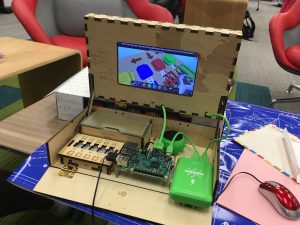Building computers
Initial feelings and assumptions
In class today we constructed Piper computers. The majority of the class had not encountered such a task before. As an Education student I have never viewed Computer construction or Computer science as a discipline that is relevant to me. Despite being a ‘digital native’ I have never felt particularly comfortable with technology. Computers and other technological devices often frustrate me and so I avoid using these devices other than in the most simple ways. When I heard that we would be building a computer in class I felt quite nervous because I didn’t think that I would succeed at the task. I feel that it is expected that all digital natives are competent in the field of computer technology, which made me feel more uneasy. A part of me also questioned the relevance of this task for a future educator. As a future ESL and humanities teacher, why would I need to know how to build a computer? My views about computer construction and technology in general have certainly changed since the completion of the piper task.
The construction experience
The task surprised me in several ways. I hadn’t realised that the computer would have step-by-step instructions on how to build it. Seeing the detailed instructions assured me that the task would be manageable. When I looked at the blue print holistically it was overwhelming due to its size, but the print was broken up into steps so we focused on one component at a time. The creators of the Piper computers employed decomposition in order to empower students to succeed in the task. My partner and I also employed abstraction in that we ignored the unnecessary steps, such as the decorative stickers, until after we had constructed the core of the computer.
My partner, Kahric, didn’t have any experience in computer building either which actually made me feel more comfortable. The process was more enjoyable because we figured it out together. If I had worked with someone who had prior experience, I may have felt useless or like a burden throughout the process. We certainly ran into some difficulties and made many mistakes. We connected some of the parts in the wrong order and used the incorrect sized nails several times. At the time these mistakes irritated me because it felt like we had wasted time. However, when we tried again and succeeded, it felt great!
Reflection and future actions
Upon the completion of this task I now recognise that the task was less about becoming competent at building computers and more about learning to employ computational thinking skills and to be persistent. When we were introduced to the concepts of computational thinking it was difficult to know what computational thinking looks like in a real world example. I was able to use and view the use of some computational thinking skills during this task, which has enhanced my understanding of it.
Additionally, the Four C’s were incredibly useful skills during this task. My partner and I collaborated effectively as we both had the shared goal of building the computer and we worked through all of our difficulties together. We shared the load evenly between us without either person taking complete control.
I believe that we communicated efficiently as we asked each other questions throughout and shared suggestions for approaches to difficulties that we had. Although critical thinking wasn’t a key part of this task given that clear instructions were given, we used critical thinking strategies when devising an approach to the task.
In the end, I actually enjoyed building the computer. The next time that I am confronted with a similar task or even a task that I have not encountered before I will no longer be filled with dread but rather with excitement. I will endeavour to pursue opportunities which will expose me to new technology and devices. I initially failed to see the relevance of Computer science and new technology for the average classroom. I recognise that the students that fill classrooms today have been brought up with technology and if teachers lack knowledge about modern technology and lack the will to implement it, then students will become disengaged. Additionally, computational thinking skills extend beyond just the realm of computer science. These skills can help teachers and students alike in any type of problem solving. This activity has made me feel better equipped to teach in the 21st century classroom and I now feel motivated to actively seek out new learning experiences to prepare me to be a great teacher.

